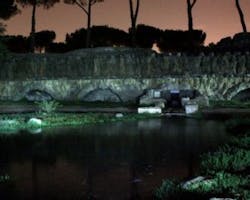Robots and 3D scanners used to map ancient Roman aqueducts
A group of amateur archaeologists—aided by caving expert group Sotterranei di Roma (Underground Rome)—are using remote-controlled robots, 3D scanners, and lasers to map ancient Roman aqueducts that had once provided the city with fresh water.
Thomas Ashby, a British topographer and archaeologist who explored the aqueducts before and after the First World War originally created the maps of the tunnels which the team is now working off of, according to The Telegraph. The team is using 3D scanners mounted on tripods to produce images of the inside of the tunnels, and laser “rangefinders” to measure the size, direction, and elevation of the tunnels.
A six-wheeled "archeo-robot" is used to navigate along passageways which are too small or dangerous for the team members to enter. The remote-controlled robot is equipped with two computers, three high-definition cameras, and laser sensors.
"It's not very nice down there and there's often a build-up of gases, so robots are ideal," said Christopher Smith, the director of the British School at Rome, an archaeological research institute established in 1901. "They're very good for getting into difficult underground areas. There are miles and miles of tunnels beneath sites like the Colosseum, for instance, much of which we know very little about."
The Aqua Claudio aqueduct, which is one of the tunnels being mapped by the team, began construction in 38 AD and ran for approximately 45-55 miles from the mountains beyond the modern towns of Tivoli and Frascati. Aqueducts such as this one used gravity to provide water and can be seen from Germany to North Africa, or what once constituted the land occupied by the ancient Roman Empire.
Editor’s note: Company names and/or developers are not listed for 3D scanners, lasers, or robot technologies.
View the Telegraph article.
Also check out:
Unmanned aquatic robots hunt and kill jellyfish
iRobot Ava 500 video collaboration robot to debut in early 2014
MIT researchers developing algorithm to improve robot vision
Share your vision-related news by contacting James Carroll, Senior Web Editor, Vision Systems Design
To receive news like this in your inbox, click here.
Join our LinkedIn group | Like us on Facebook | Follow us on Twitter | Check us out on Google +
About the Author

James Carroll
Former VSD Editor James Carroll joined the team 2013. Carroll covered machine vision and imaging from numerous angles, including application stories, industry news, market updates, and new products. In addition to writing and editing articles, Carroll managed the Innovators Awards program and webcasts.
